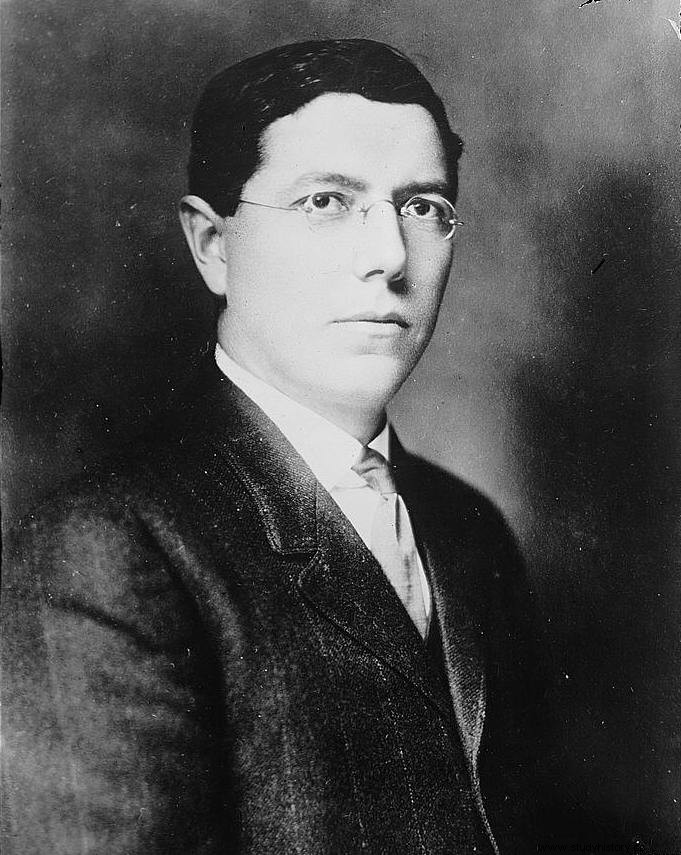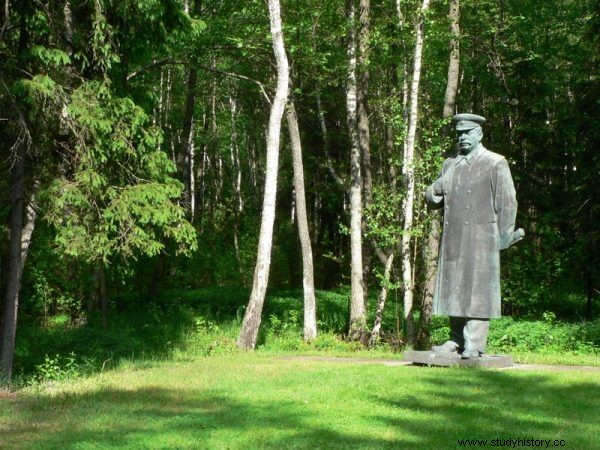The fertilization of women with methods used in cattle breeding. "Growing" people for workforce and for beauty shows. And finally, an attempt to cross a human with a chimpanzee. What were a handful of charlatans capable of meeting Stalin's superpower ambitions?
In the first years after gaining power in Russia, the Bolsheviks were impressed by the pace of industrial development in the USA. They were fascinated by American cars, airplanes, big factories, inventions and scientific achievements. They intended to imitate the patterns across the ocean. The situation began to change after the death of Vladimir Lenin. Within a few years, his self-proclaimed successor - Joseph Stalin - subjugated the party and the state.
Stalin's attack on the fortress of science
Stalin quickly departed from "capitalist" modifications of Marxist doctrine such as the Leninist NEP (New Economic Policy 1921-1929, introduced primarily to combat universal hunger). He preferred big state campaigns, written in the form of five-year plans. In this way, the party took complete control of the country in all possible areas of human activity, including scientific activities. Russia was supposed to be the first country in the world to be ruled by scientific methods .

When in 1919 Stalin and Lenin posed for this photo with Mikhail Kalinin, Lenin probably did not think that his ideological friend would betray the concepts he had developed as soon as he took over the rule of the state.
In 1928, the party called on scientists to submit proposals for the first five-year plan. In the book "Stalin and Scientists", which has just been published in Polish translation, the English writer Simon Ings quotes Stalin's speech from May 1928:
There is a fortress in front of us. This fortress is a science with a whole host of fields of knowledge. We have to get this fortress at any cost. (...) What we need now, comrades, is a massive attack by revolutionary youth on [fortress] of science.
Produce a new human being
One of the problems of the young Soviet state was the demographic crisis caused by World War I, the revolution and the famine and epidemics of infectious diseases. It is estimated that 16 million Russian citizens have died in six years since the beginning of the war. In 1917-1920, Moscow itself lost almost half of its population, and Petrograd lost 70 percent of its population. Russia needed a demographic boom, and the Bolsheviks and the scientists obedient to them boldly drew their visions.
Aleksander Sieriebrowski, who headed the poultry breeding department at the Moscow Zoological Institute, published a pseudo-scientific article entitled "Human genetics and eugenics in a socialist society". He recommended a massive action of voluntary artificial insemination of Soviet women with methods used in cattle and horse breeding .

The article was inspired by the latest book by Simon Ings, “Stalin and Scientists. A history of triumph and tragedy "(Agora Publishing House 2017) about the crazy ideas of Soviet scientists who have become the laughing stock of the world.
"Given the enormous ability of men to produce sperm (...), one healthy and valuable producer would be able to sire up to a thousand children ... Under these conditions ... countless women and entire communities could pride themselves on ... producing new forms of beings human "- wrote Sieriebrowski, claiming that his ideas will make it possible to implement five-year plans in two and a half years.
The author of the article was officially reprimanded for "offending Soviet femininity," but he was not the only supporter of "producing new forms of human beings." The more famous one turns out to be Ilya Ivanovich Ivanov, who already before the revolution gained international recognition for his research on artificial insemination. In the early 1920s, he corresponded with the American biologist Raymond Pearl on the possibility of crossing a human being with a chimpanzee .
"Orango has died, we are looking for a replacement"
The interest in the project turned out to be huge. In the People's Commissariat of Education, Ivanov's research area was recognized as "an extremely important problem of materialism." Lew Fridrichson of the People's Commissariat of Agriculture argued that:
The topic raised by Professor Ivanov (...) should become a decisive blow inflicted on religious teaching and can be efficiently used in propaganda and in the fight for the liberation of working people from the authority of the Church .

Raymond Pearl (pictured) was an American biologist specializing in classical genetics. Ivanov decided to turn to him for advice when he began to plan the implementation of his crazy idea:a human-chimpanzee cross.
In 1925, Ivanov won the approval of the Soviet Academy of Sciences for his experiment and, with the equivalent of 10,000 dollars, left Russia for international support. Soon it hit the headlines. The New York Times published a provocative article about plans to crossbreed humans with chimpanzees and at the same time threatening letters from the Ku Klux Klan. Meanwhile, supported by the Pasteur Institute in Paris, Ivanov reached African Guinea, but the first attempt at the crossword puzzle failed.
The Russian then returned to the Moscow Animal Husbandry Institute with the intention of using primate semen to fertilize women in Russia. Surprisingly, he quickly found a few willing companions. One resident of Leningrad wrote to Ivanov on March 16, 1928:
Dear Professor (...). My life is ruined and I don't see any sense in further existence (...). But when I think I might study, I have the courage to contact the Lord. Please do not refuse me. Please accept my offer to participate in the experiment .

The Russian Academy of Sciences was founded in 1724 in St. Petersburg. In the years 1925-1991 it was renamed the "Academy of Sciences of the USSR", and its headquarters were moved from St. Petersburg (pictured) to Moscow. It was here, among others, that scientists who made a pact with the communist authorities conducted their research under the watchful eye of Stalin.
The matter dragged on, however, so much that in the end - as Ivanov wrote back to the volunteer - "the orange has fallen, we are looking for his replacement " . Ultimately, Ivanov's career crumbled when the Academy of Sciences discovered that the scientist was trying to impregnate African women ... without their knowledge.
An improvement of the human race
In the 1920s, eugenics briefly gained popularity among the elites of Soviet Russia. The Bolshevik state was no exception. The idea of selective reproduction of animals, people and plants for the improvement of species spread in the scientific community of many countries as early as the end of the 19th century. The very concept of eugenics was introduced in 1869 by the British, Francis Galton, Charles Darwin's cousin.

Eugenics, a concept introduced by Francis Galton (pictured), was about trying to improve species from generation to generation. With its use by the National Socialist regime, this teaching began to have clear negative connotations.
As Galton argued, animal breeders only crossbreed the healthiest specimens, and prevent the breeding of sickly individuals who go to the slaughterhouse first. Since human beings are also animals, their reproduction can be planned like that of chickens or dogs .
The Russian Eugenics Society was established in 1922. In a work entitled "The Improvement of the Human Race", presented at the inaugural meeting of the association, Nikolai Koltsov vividly described selective reproduction. He imagined an invasion of Martians who would treat us the way we treat livestock. People would be "domesticated." Rebellious individuals would be liquidated, docile individuals would produce offspring for labor, and the most beautiful would be bred for beauty shows. In the following decades of Soviet Russia some of these crazy ideas were - horrifyingly - put into practice.

It is not known who was the greater madman - a scientist who tried to implement Stalin's superpower ambitions, or the Soviet dictator himself who initiated genetic experiments. However, as you can see in the photo - monuments are erected to unpredictable people.
We are solving the problem of heating Siberia
The Soviet government expected scientists to put into practice ideas. On this occasion, a lot of bizarre projects and common scams saw the light of day. The Invention Commission, acting as a patent office, reported the case of a "scientist" without formal training, who received 200,000 rubles, and an "electrical biology" laboratory to investigate how ultra-short wave bombardment of seeds increased yields. Eventually, the militia tracked him down at a nightclub in Leningrad.
The work of an Ashgabat physicist who made it rain with electrified smoke was seriously debated. The Marxist philosopher Isaac Gift proudly proclaimed:
We are doing the biggest job - a planned climate change (…). We organize a special institute to deal with creating or stopping rain (...). We will irrigate the dry regions of the country and carry out a massive attack on the deserts. We are also solving the problem of heating Siberia .

I wonder what Stalin looked like when he was handed over to him another bizarre ideas of Soviet scientists ....
Comrade Stalin and Eternal Life
As Oleg Khlevniuk, Stalin's biographer writes, Soviet leaders were very interested in the study of longevity. Ings, in his latest book "Stalin and Scientists" adds that:
(...) they naively gave [they] belief in the effectiveness of various "state-of-the-art" rejuvenation techniques such as transplant glands from monkeys, vasectomy, (...) and finally the use of gravidan - a mysterious substance isolated from the urine of pregnant women .
Surprising careers in the Soviet empire were made by two controversial specialists in this field, although the first of them did not enjoy his fame for a long time.

Olga Lepieszynska and Aleksandr Bogdanow. Certainly these people cannot be called geniuses. However, they can certainly be counted among the ranks of Soviet pseudo-scientists whose theories were not only bizarre but also dangerous. Bogdanov overpaid his ill-considered experiments with his life.
Alexander Bogdanov promoted blood transfusions as a method of regenerating the body. He claimed that they ensure better sleep, improve the complexion, correct vision defects, strengthen immunity and remove fatigue. However, Bogdanov's experiments ended tragically. In 1928, he exchanged blood with a student and suffered hemolytic shock, as this was the eleventh transfusion he had undergone. He died two weeks later.
Olga Lepieszynska recommended rejuvenating soda baths. It is also famous for the pseudoscientific theory that living cells do not have to arise from other living cells. This would mean that man - like God - can breathe life into inanimate matter. As proof, she produced a video that was in fact a hoax. She filmed the death and decay of the cell, then ran everything from behind on the projector. Nevertheless, in 1950 she received the Stalinist Prize, established by Stalin himself in 1939, for outstanding scientific achievements .
Bibliography:
- Czapski Józef, In inhuman land , Znak, Kraków 2011.
- Fitzpatrick Sheila, Stalin's team , Czarne, Wołowiec 2017.
- Goworscy Marta and Andrzej, Scientists from under the red star , PWN, Warsaw 2016.
- Holloway David, Stalin and the bomb , Prószyński i S-ka, Warsaw 1996.
- Ings Simon, Stalin and the scientists , Agora, Warsaw 2017.
- Khlevniuk Oleg, New Biography , Znak Horyzont, Krakow 2016.
- Köhler Piotr, Studies on baldness in Polish biology , Dante, Krakow 2013.
- Medvedev Zores, Medvedev A. Roj, Unknown Stalin , Videograf, Chorzów 2006.
- Montefiore S. Simon, Court of the Red Tsar , Magnum, Warsaw 2004.
- Pipes Richard, Bolshevik Russia , Magnum, Warsaw 2005.
- Rapoport Yakov, Stalin's last crime. 1953:The conspiracy of Kremlin doctors , Erica, Warsaw 2011.
- Andrei Sakharov, Memories , Pomost, 1991.
You can buy the book at empik.com:

